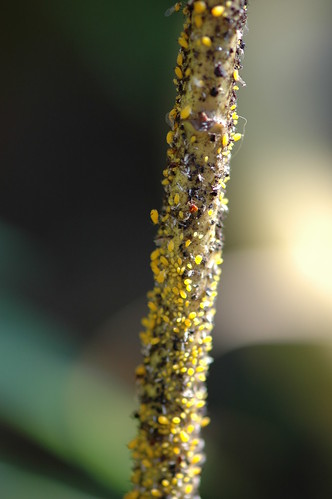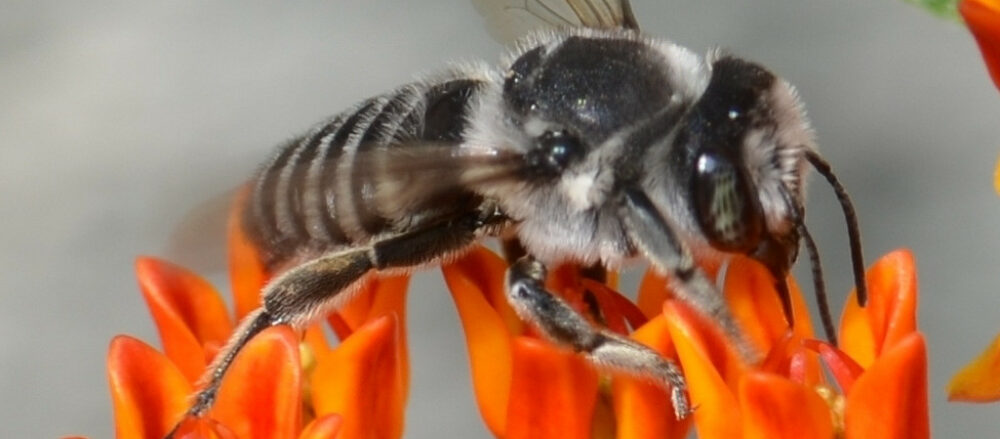Updated 2008.06.10: Expanded section on biological controls. Added more references.
An aphid viewed through a microscope, taken the first night of my IPM class at BBG
Why are aphids so hard to control? Here’s one answer:
Most species of aphids overwinter in the egg stage. The eggs hatch in the spring to produce a generation of females. These female aphids give birth to living young. Generally the first young aphids are wingless and when a colony becomes too crowded winged forms may be produced. The winged forms migrate to new host plants and begin colonies. Enormous populations are built up from these overlapping generations all summer long.
– Aphids Factsheet, Insect Diagnostic Laboratory, Cornell University
So, to sum up:
- Overwintered eggs hatch females.
- Females give birth to live young (first instar), up to 70 at once.
- They have multiple generations during the year.
- The population responds to overgrazing by flying to new locations. They can fly several miles on the wind.
- They start all over again the next year.
To this I can add that, the earlier you catch and deal with them, the less effort it will be. A week can make a huge difference. But more on techniques below.
This post is actually a homework assignment for my Pest Management class at the Brooklyn Botanic Garden. I had a choice of three insect pests – spider mites, aphids, and hard scale insects – to answer the question:
What makes [your pest here] so difficult to control?
I chose aphids because a neighbor wrote recently about her problem with aphids on her cilantro and an encounter with a vicious ladybug. She complained that her ladybugs always flew away. I suggested lacewings as an alternative predator, and additional plantings to attract, and keep, “beneficial” insects.
Managing Aphids
Understanding a pest’s life cycle and monitoring for it are important aspects to managing it. I’ll highlight a few categories of techniques for controlling aphids: horticultural, physical, biological, and chemical. I’ll address biological controls last, and spend most of the time on that topic.
Since eggs overwinter, horticultural practices such as removing dead plant material before aphids hatch in the spring is a first step. Clearly, this will be most effective when it’s done before the first aphids emerge. Another important horticultural strategy is to plan and plant diversity in the garden. More on this in the section about biological controls, below.
Physical controls can be effective, especially earlier in the spring when populations are still relatively small. This could include washing them off with a stream of water, removing infested parts of the plant, and, for the non-squeamish, squishing them and picking them off by hand. Some sources even suggest mulching with foil to repel aphids and other pests.
Chemical controls really are a last resort. Insecticides poison both the target and its predators. It’s generally not a good strategy to poison the things that eat the things you’re trying to control. For aphids, insecticidal soap can be used to target just the affected areas of the plant.
Biological controls
My preference is for biological controls. There are many naturally occurring predators and diseases of aphids, including:
- lady beetles (lady “bugs” are really beetles, not bugs)
- lacewings
- predatory midges
- flower fly larvae
- pirate beetles
- Braconid wasps
- parasitic fungi
Given this list of natural enemies, it’s no wonder aphids have evolved a strategy of rapid, massive reproduction. One can even see the value of having some aphids in the garden, since they’re important food sources for so many other insects!
In the past, I’ve introduced both ladybugs and lacewings to my gardens. These days, I try instead to keep a balance of plants in my gardens, including plants that provide alternative food sources or refuge for insect predators. There are plenty of natural predators around, even in city gardens. There are also fungal diseases that occur naturally, but are not commercially available, which attack aphids.
Learn to recognize and conserve insects that prey on or parasitize pests. Small wasps, for example, parasitize aphids, leaving bloated gold to bronze “mummies.” Immature lady beetles and lacewings, which look like tiny alligators, also frequent gardens. Other “beneficials” include spiders, predatory mites, predatory bugs, predatory flies, and ground beetles.
– Managing Insect Pests in Vegetable Gardens, Home Gardening Resources, Cornell Univers
Biological controls are not a panacea. For example, most of the commercially available ladybugs are species not native to North America. They are commercially available because they are amenable to raising in the large numbers needed for economic viability, not necessarily because they are the best choices. These can become pests in their own right when they swarm and overwinter in homes to emerge in the Spring.
In addition, native species have become scarce, even endangered. Two years ago, New York state changed its official insect from one ladybug species to another because the original species had become extinct in the state. This reduction in population coincides with the spread of non-native species in the wild.
The New York State insect is essentially no more. Once among the most common ladybugs in the eastern United States, the nine-spotted lady beetle has not been seen since 1984. This comely reddish-orange beetle with four spots on each wing and a shared one in the middle has been displaced by a voracious cousin with seven spots, imported by the millions from Europe in the 1970s as a biological control agent.
The idea made sense at the time. Entomologists had observed that lady beetles eat aphids, so thought that a more aggressive species would be only that much more effective in controlling these common crop pests. They were, so much so it turned out, that the imported beetles monopolized the food source and apparently starved the natives out.
– Invaasion of the Species Snatchers, College of Agricultural and Life Sciences, Cornell University
So how can we take advantage of naturally occurring species? Plant a diverse garden, and plant for beneficial insects. For example, clovers are attractive to several kinds of insects which prey on aphids, including, wasps, pirate bugs, aphid midges, and of course, ladybugs. Buckwheat attracts lacewings, in addition to wasps and ladybugs. Plants in the Apiaceae (Umbelliferae) and Asteraceae (Compositae) support a wide range of insect species.
A heavy outbreak of aphids on Swamp Milkweed, Asclepias incarnata, in my backyard in October of last year.
Related Content
Links
The Bug’s No Lady, Brooklynonmetry, June 6, 2008
Aphids Factsheet (also available as a PDF), Insect Diagnostic Laboratory, Cornell University
Managing Insect Pests in Vegetable Gardens, Home Gardening Resources, Cornell University
Sucking insects: Aphids, Integrated Pest Management, University of Connecticut
Use of Cover Crops and Green Manures to Attract Beneficial Insects, IPM, UConn
Wikipedia: Aphid
The Lost Ladybug Project
The Decline of C-9 – New York’s State Insect
Invaasion of the Species Snatchers, College of Agricultural and Life Sciences, Cornell University
New York’s state insect, the nine-spotted lady beetle, rediscovered in eastern U.S. after 14 elusive years, April 17, 2007


